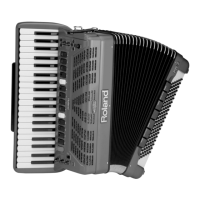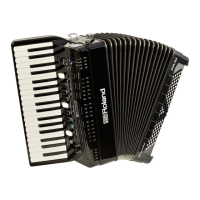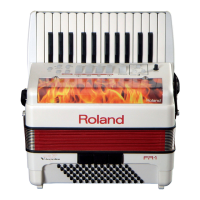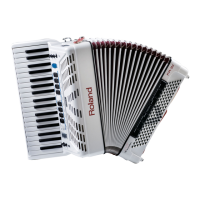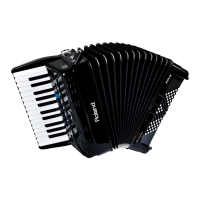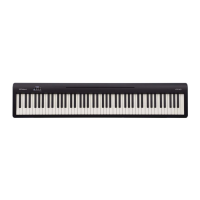Selecting Parameters
75
Parameter Value Explanation
After-
touch
O, On
Default: On
The right hand keyboard of the piano-type
model also generates aftertouch messages
(on the button-type model, aftertouch
can be generated with the Master bar).
Aftertouch is usually used for temporary
changes to a sound’s volume, tone or
pitch (this needs to be set on the receiving
instrument). Used right, it can be a very
powerful expressive tool.
Select “O” if this message type should not
be transmitted.
Select “On” if you want to transmit
aftertouch messages.
Sustain
O, On
Default: On
This parameter allows you to enable the
transmission of sustain values (CC10) to an
external device.
The sustain can be controlled by Chin
Switched ( p. 98), Function Switches (p.
106) or by an optional MIDI foot controller
(e.g. FC-300) connected to the MIDI IN socket
of FR-8x ( p. 107).
2.8 Name
This page allows you to name the currently
selected accordion register for easy reference
while performing with the FR-8x.
The FR-8x suggests the name of selected register.
1. Use the [DATA/ENTER] knob to enter the desired name.
See “How to type a name in FR-8x” (p. 31).
2. Press [EXIT/JUMP] button to exit from the selection.
3. Bass Edit parameters (Accordion)
The parameters of the Bass Edit group apply to the Bass section
(bass and chord notes) and are saved to the selected Set. They
allow you to build your own (virtual) accordion. See “Selecting
Parameters” (p. 68) for how to select and adjust the parameters.
Press [UP] and [DOWN] simultaneously to select the value that is
indicated as “Default setting”.
NOTE
These parameters cannot be selected if the Free Bass section is
activated.
Introduction to Bass Parameters
All changes you make here apply to the last Bass register you
selected. So be sure to select LEFT HAND [BASS & CHORD] button
and press the register whose settings you wish to change before
selecting and editing any of the Bass Edit parameters. You can,
however, decide to save your settings to a dierent register if you
realize that you’ve been editing the wrong one.
IMPORTANT NOTE
The FR-8x internal memory remembers your settings while the
FR-8x is switched on. While editing, there is no absolute need
to save your settings. Be aware, however, that all changes are
lost when the FR-8x is switched o.
See “How to Save a Set” (p. 42) to save your changes. Also
be sure to read “Important remark about saving your settings”
(p. 70).
3.1 Reed Type
These parameters allow you to transform the
selected register into a dierent instrument, and
to assign dierent sounds to each reed the register
plays.
See “2.1 Reed Type” (p. 71) for a discussion of
the possibilities and the aspects you need to pay
attention to.
Bear in mind, however, that the parameters on this page apply to the
selected bass register.
Parameter Value Explanation
FOOT All, 16’, 8’, 8’-4’, 4’, 2’’
Chose the reed you wish to assign
another sound to.
NOTE
Whenever you select “All” and
set a dierent reed type, the
“Valve Noise” setting ( p. 72) is
automatically adapted to the reed
type you select here. You may have
to change it afterwards if you wish
to use a dierent noise type.
TYPE
Bandoneon, I-Folk,
I-Folk2, Classic,
Cajun, Jazz, F-Folk,
D-Folk, Organetto,
F-Folk2, Classic2,
Studio, Tradition,
Steierische,
Trikitixa, F-Jazz,
Classic3, Bajan
Select a type of instrument.
TIPS
To save time while changing the
“TYPE” setting of one or several reeds,
you could proceed as follows: suppose
all reeds are currently set to the wrong
TYPE and you want to use 16’, 8’ and 4’
as “Bandoneon”. In that case, set FOOT
to “All” and TYPE to “Bandoneon”.
Now, all reeds use the “Bandoneon”
setting. Now use “TYPE” to switch o
the reeds you do not need.
3.2 Register
The parameters on this page are used in
combination with the parameters above.
Here, you decide which reeds should be audible
and how they should be played. It is therefore on
this page that you specify whether the sounds you
selected above will be used.
Parameter Value Explanation
BASS All, 16’, 8’ Chose the reed you wish to edit.
STATUS O, Bass
• “O”: No sound
• “Bass”: Sound
LEVEL O, –40~Std~+40
This parameter can be set for each
reed/footage individually. It allows
you to create the desired “mix”
(volume balance) for the active reeds.
This is a relative parameter: its value
is added to or subtracted from the
standard value (“Std”). As a rule, rst
decide which reed is most important
and set its “Volume” parameter to
“Std”. Then reduce or increase the
volume of the “ancillary” reeds to
create the desired balance.
CHORD All, 8’-4’, 4’, 2’ Chose the reed you wish to edit.
STATUS
O, Chord, Bass &
Chord
• “O”: No sound
• “Chord”: Sound
• “Bass & Chord”: Sound

